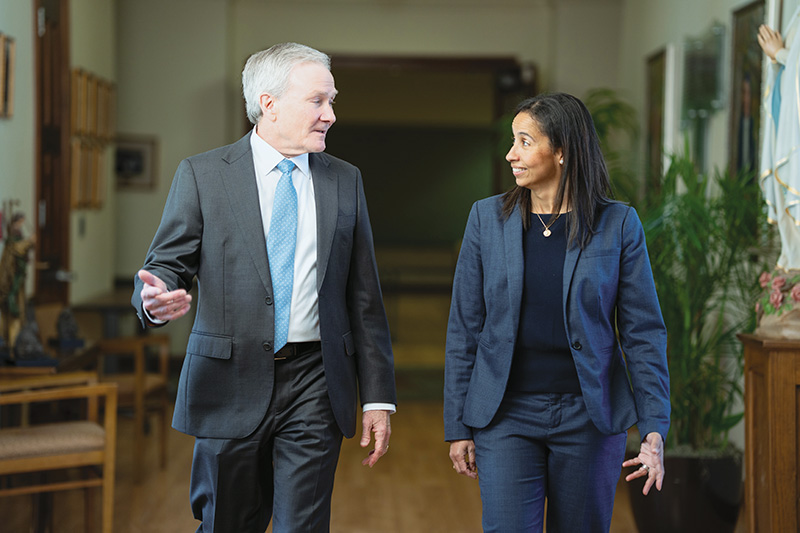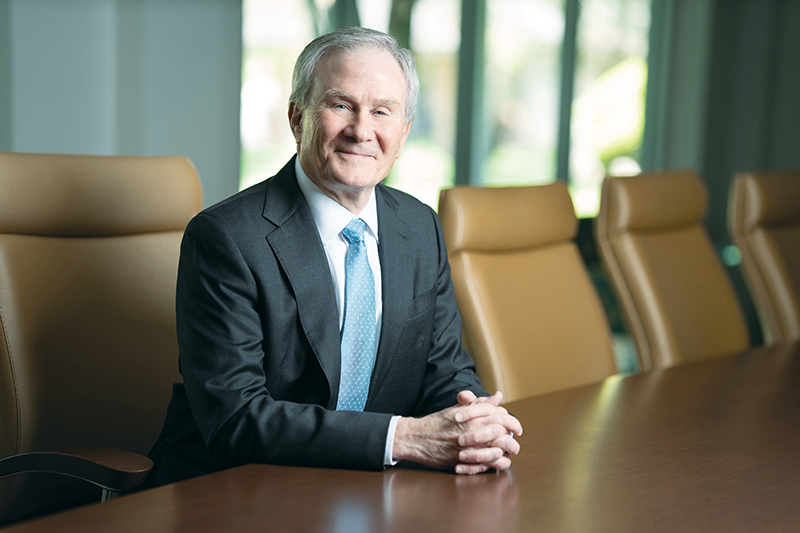
When Dr. Richard Vath retires this summer as president and CEO of Franciscan Missionaries of Our Lady Health System in Baton Rouge, Louisiana, he will cap off a career spanning 40 years.
Vath had practiced in Baton Rouge for 23 years as a pulmonary critical care physician before joining the leadership team of FMOLHS' Our Lady of the Lake Regional Medical Center in 2006 as quality and patient safety medical director. In 2019, Vath was named president and CEO of FMOLHS, which has five hospital campuses and a network of outpatient sites in Louisiana and Mississippi. Beginning May 1, E.J. Kuiper will transition to system president and CEO.
During his tenure as CEO, Vath helped set a long-term vision for FMOLHS, spearheaded its expansion in Mississippi and Louisiana. He also led the system through the pandemic as well as through the clinical and financial challenges that have followed.
He spoke to Catholic Health World about what drew him to medicine and to ministry system leadership. His responses have been edited for length and clarity:
How did you become interested in a career in medicine?
The easiest answer is that it was serendipity. There are no physicians in our family — we are a very right-brained family. I was interested in science and in life sciences and had planned to be a marine biologist. On a lark, my cousin had applied to med school and enjoyed it and I decided to do the same.
Once I was in my residency, I realized I enjoyed the blend of art and science in internal medicine. I enjoy the process of gleaning symptoms, building a story of the illness. I love interacting with the patient to build the story of the illness and then applying the blend of art and science to help the patient.
What were some of the main challenges you faced as a physician?
The biggest challenge was when I was part of a small group of just three pulmonary care physicians managing patient care at four different hospitals in Baton Rouge. We were on call on a rotating basis. It took a psychological and emotional toll because we were taking care of the very sick. Many died. We learned to really face challenges. We had to squash our emotions to perform. Critical care physicians tended to do better in COVID because we are used to compartmentalizing our emotions.
What we learned then and what hospitals are learning now is we had to work as teams and it's important to recognize the need to develop the team — the scrub techs, the nurses, the physicians. As more physicians moved to hospital-based environments, they suddenly needed that skill, of developing teams. And I'd had to develop that skill already, and that served me well in leadership roles.

What are some of the main changes you've witnessed in medicine over your career?
There have been changes in the pressures as medicine has evolved into more subsegments of specialized units. That requires specialized training. So you require physicians to have more experience over time, and medicine becomes more compartmentalized. And this amplifies the staffing issues. This was seen, for example, during COVID when pulmonary care physicians were burning out. Hospitals couldn't find their expertise with other clinicians. Given the physicians' compensation and the facilities' revenues, hospitals couldn't keep up with the cost of care. It became an insurmountable task.
It's hard as a leader not to use traditional thinking. We had to transform six different areas of the hospital just to keep up with the volumes of patients coming in during COVID. It was a little easier for me as a system leader with my clinical background — I understood the disease clinically. And coming from Louisiana we were used to setting up incident command centers because of hurricanes. It was clear to me as COVID started we had to set up incident command, because we do that every year during hurricane season.
It actually was post-COVID that was more difficult.
Why was the aftermath of the COVID peak more difficult?
The real issues for all of us go back to the super-specialization of hospital care. The real challenge was the burnout and people not being interested in doing this hard work in these circumstances anymore. And we all are dealing with this in different ways. We doubled down on engaging our workforce partners, including Louisiana State University. We are working to attract new workers, build relationships as a team, and support them. Our mission team has worked with HR to continue to support our staff, and that's been a huge effort.
What has improved most in medicine over the course of your career?
The team efforts towards quality have improved most. In 1983 when I started practicing medicine, we did not have the quality standards we have today except for the regulations and compliance guidelines that we had. In 1999, the Institute of Medicine published To Err Is Human, and two years later it published Crossing the Quality Chasm, and this asked: 'What should quality look like?' and 'How do we define and execute on quality?' And we saw change. This started a passion of mine, and I came in to Our Lady of the Lake to set up this quality-related work. I had studied teams of physicians and how to influence behavior to promote quality.
Then, we started to look at population health, the need to look at quality outcomes outside of the hospital. We looked at: How do we get everyone on the same page? This is a huge focus for us, and we are in the top 5% of the country when it comes to quality. Our work with accountable care organizations has enabled us to define and clarify what our mission is and how that relates to quality outcomes.
What attracted you to leadership in Catholic health care?
I've always been interested in leadership and raising people's performance. I realized that there were lots of patients cared for by providers who didn't have the proper training. I asked myself, how can we raise everyone up? And I became interested in raising standards, including by working through the electronic medical record. I saw that I could make a bigger impact and on a larger scale through leadership. And so I led quality and safety efforts at Our Lady of the Lake.
I used my background to learn how to motivate change in physicians.
What has it been like to be a leader in Catholic health care in particular?
I had practiced at Our Lady of the Lake as a physician, but as a leader I learned more about the mission and was impressed at how this small group of introverted women had created these facilities that are part of our system, and I saw how these nuns were so effective in inculcating their mission. When I became CEO I said I needed to understand this better. I took CHA's sponsor formation course and figured out it's not just about how we relate to each other as a team but also with the church.
What are some of the joys you've had as CEO of this system?
The biggest joy, and I'm going to miss this most, is working with the people here. It's been a joy watching them develop their talents and rise to the occasion and for all of us to learn together. As a Franciscan system, we are a relationally driven organization, and I've worked on marrying that relational and the performance-driven aspects of our work together.
What insights would you share with other Catholic health care leaders?
I've never had a more fulfilling role as this, and it's humbling to realize that there is still much work to do. A big focus for the next generation of health care leaders in the ministry is that not only do we really need to build and strengthen Catholic health care, we also need to drive the triple aim. We need to continue to demonstrate quality outcomes. We need to change the quality of care and focus on the health of populations. We have to figure all this out, and also figure out how to lower the total cost of care — or I'm not sure what will happen in the long haul.
To do this work, we have to make sure we continue to take seriously the formation of leaders in the Catholic health care ministry, or we won't be able to continue to pursue our mission and vision.
